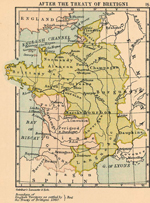|
Treaty of Brétigny 1360
The Treaty of Bretigny is also spelled the
Treaty of Bretigni, or the
Treaty of
Bretigny. It was concluded on May 8, 1360.
In a Nutshell
The Treaty of Bretigny was concluded between England
and France.
By it, Edward III renounced his pretensions to the
French crown. The treaty was ill kept, and indecisive hostilities
continued between the two countries.
In More Detail
After
 French King
John II had been captured by the English during the
French King
John II had been captured by the English during the
 Hundred Years' War, his freedom was offered in exchange for
money. Hundred Years' War, his freedom was offered in exchange for
money.
The Treaty of Brétigny stipulated that the French
had to pay three million gold crowns to secure the release of their king. To
put this figure into perspective: English
 King Edward made
approx. 600,000 crowns per year.
King Edward made
approx. 600,000 crowns per year.
The Treaty also specified that
Aquitaine, Poitou, and Calais would be English domain.
The French couldn't come up
with the dough, so the English accepted hostages instead. However, the
hostages fled, the French king turned himself in again and died
shortly after.
The son and heir of the French king didn't give a rat's
arm about previous treaties and thus the Hundred Years' War
resumed.
And here is the map of France after the Treaty of Bretigny

France After
the Treaty of Bretigny
Click on map to enlarge
More History
|